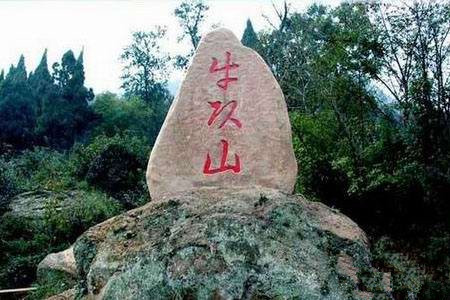
Niutoushan Mountain in Luliang County, Qujing
Overview
Niutoushan (牛头山), also known as Niutou Mountain, is located in Xiaobaihu Town (小百户镇), northwest of Lujiang County (陆良县) and approximately 30 kilometers from the county seat. Historically referred to as Qimao Mountain (契茂山) and Tianzhushan (天柱山), it is one of the “Three Mountains” listed in Zixi Chuan (紫溪传), which mentions the notable landscapes of the region. The Ming dynasty scholar Fu Zonglong (傅宗龙) from Kunming (昆明) remarked that Niutou Mountain is listed among the Five Great Mountains of Huaxia (华夏), renowned both within and beyond the province.
Historical Significance
Niutoushan is an ancient landform with its highest elevation noted in local records. The mountain is famous for the “Eight Scenic Views of Niushan” (牛山八景), which include:
- Jueding Motian (绝顶摩天) – The peak reaching the sky
- Wanshan Yonglang (万山拥浪) – Waves embraced by mountains
- Shanjiao Xuri (山椒旭日) – The sunrise over the mountain
- Haopai Chusheng (皓魄初升) – The bright moon rising
- Fan Feng Qiutan (帆峰秋潭) – Autumn pools at the peak
- Guoyuan Yanha (古院烟霞) – Misty scenes in the ancient courtyard
- Linjian Songyun (林间松韵) – The sound of pines in the forest
- Jichang Chenzhong (鸡唱晨钟) – Roosters crowing at dawn
Historically, there was an ancient temple called Zhenqing Palace (真庆宫), also known as Tianzhu Temple (天竺寺) or Niutou Mountain Temple (牛首山寺), located halfway up Niutou Mountain. This temple, a significant site for Taoism (道教), was built during the Yongle period of the Ming dynasty and has been renovated through the ages. During the early Republic of China, Taoist priest Zheng Zhirong (郑芝荣) oversaw significant renovations, ensuring that the temple adhered to Taoist principles. The temple, along with the Zhenwu Temple (真武观) located outside the south gate of the county seat, is regarded as a notable Taoist site. One of the Eight Scenic Views of Lujiang, “Niushan Qingshu” (牛山清暑), is derived from this area.
Scenic Features
Niutoushan is rich in historical sites, including the ancient fortress known as Niushan Guzhai (牛山古寨). This ancient site covers hundreds of acres, featuring a circular layout with remnants still visible. The central area includes a massive stone known as “Dianjiangtai” (点将台), weighing several tons. The fortress is backed by mountain ranges, with cliffs in front and gently sloping terrain to the sides, creating a spacious environment. The exact date of its construction remains a mystery and requires further investigation.
The scenic resources of Niutoushan are abundant, boasting a variety of landscapes, including:
- Forest Landscapes: Unique tree formations, large ancient vines, and stunning cloud formations.
- Geological Features: Majestic formations such as Niutou Mountain, Tianshi Peak (天师峰), and Tianbeng Gorge (天崩峡).
- Water Features: Scenic waterfalls like the “Zhezhong Great Waterfall” (浙中大瀑布), mysterious flow clouds, and picturesque streams.
Today, the ancient fortress is not only an archaeological interest for historians but also a popular destination for tourists seeking adventure and exploration.
How to Get There (Transportation)
To reach Niutoushan, you can take a bus from Qujing City (曲靖市) to Lujiang County. From the county seat, taxis or local transport can take you to Xiaobaihu Town, where Niutoushan is located.
Travel Tips for This Attraction
- Dress Appropriately: Wear comfortable shoes suitable for hiking, as the terrain can be rugged.
- Bring Essentials: Carry water, snacks, and sun protection, as you may spend several hours exploring the area.
- Respect Nature: Follow designated trails and avoid littering to help preserve the natural beauty of the mountain.
- Guided Tours: Consider joining a guided tour to gain insights into the history and significance of the various sites.
- Photography: Capture the stunning landscapes, but be mindful of local customs and restrictions regarding photography in sacred areas.

 7 Days GolfingTour
7 Days GolfingTour
 8 Days Group Tour
8 Days Group Tour
 8 Days Yunnan Tour
8 Days Yunnan Tour
 7 Days Shangri La Hiking
7 Days Shangri La Hiking
 11 Days Yunnan Tour
11 Days Yunnan Tour
 6 Days Yuanyang Terraces
6 Days Yuanyang Terraces
 11 Days Yunnan Tour
11 Days Yunnan Tour
 8 Days South Yunnan
8 Days South Yunnan
 7 Days Tea Tour
7 Days Tea Tour
 8 Days Muslim Tour
8 Days Muslim Tour
 12 Days Self-Driving
12 Days Self-Driving
 4 Days Haba Climbing
4 Days Haba Climbing
 Tiger Leaping Gorge
Tiger Leaping Gorge
 Stone Forest
Stone Forest
 Yunnan-Tibet
Yunnan-Tibet
 Hani Rice Terraces
Hani Rice Terraces
 Kunming
Kunming
 Lijiang
Lijiang
 Shangri-la
Shangri-la
 Dali
Dali
 XishuangBanna
XishuangBanna
 Honghe
Honghe
 Kunming
Kunming
 Lijiang
Lijiang
 Shangri-la
Shangri-la
 Yuanyang Rice Terraces
Yuanyang Rice Terraces
 Nujiang
Nujiang
 XishuangBanna
XishuangBanna
 Spring City Golf
Spring City Golf
 Snow Mountain Golf
Snow Mountain Golf
 Stone Mountain Golf
Stone Mountain Golf


















